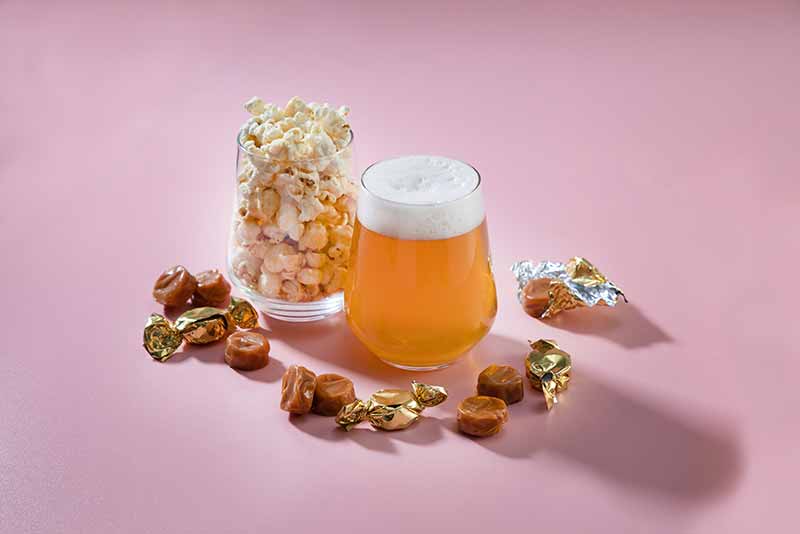
Tight brewing processes are always crucial for creating great beer. However, adding ways to shore up any would-be issues before they arise is also helpful. We wrote last year about how mash hopping has a number of benefits and serves as an insurance policy for a beer’s finished product. Along those lines, the Alpha Acetolactate Decarboxylase, or ALDC, produced by U.K.-based Murphy & Son, can prevent diacetyl from forming and has other benefits that help improve your finished beer.
We chatted with Murphy & Son North America Technical Sales Rep Graham Doherty to learn about ALDC’s R&D process, benefits, and dosage rate and in which beers it works best.
(Above graphic courtesy of Murphy & Son Limited)
Affordable, Industry-Leading Brewery Software
What Exactly Is ALDC?

Graphic courtesy of Murphy & Son Limited
Simply put, ALDC skips over the formation of the buttery flavor of diacetyl in beer, going from the precursor acetolactate straight to acetoin, which emits no flavor.
“[ALDC] speeds up the rate-limiting step involved with diacetyl formation, converts the precursor to the final product acetoin, and bypasses the formation of diacetyl altogether,” Doherty explains.
The flowable product, which should be stored at refrigerator temperatures and has a shelf life of about a year and a half, is a naturally produced enzyme from an isolated Bacillus subtilis bacteria strain.
“The enzyme is run through a sterile filter to completely separate it from the bacterial source,” Doherty says.
What Was the R&D Process for ALDC?

Graphic courtesy of Murphy & Son Limited
Murphy & Son worked with a large-scale industrial manufacturer to produce ALDC. Sold in the U.K. since 2009, the product began to surface in the U.S. in 2012. Things really picked up in the U.S. market in 2017 when a previous technical sales rep did a presentation on ALDC and its benefits at the Craft Brewers Conference (CBC). Doherty says that the promise of ALDC began to show much earlier.
“We first realized the potential of ALDC in the mid-1990s and did enough experiments to realize it was a good product,” he says. “At that time in the U.K., other than the large multinationals, a large proportion of our customers were primarily cask ale brewers who didn’t really have or notice diacetyl issues.”
Because of that, getting data in breweries was difficult as there was a distinct lack of lager breweries or dry-hopped beers—where ALDC can shine (more on that in a moment).
“A few years later, a brewer, who we had known on the scene for a while, Johnny Stancill, had taken over as head brewer at Oakwell Brewery in Barnsley,” Doherty says. “Relatively uniquely for that time, Oakwell Brewery produced relatively small batches of beer for its own small pub estate. Unlike most of the breweries of its size, it had the ability to keg beer, and it actually produced a lager with prolonged maturation and diacetyl resting using a repatched lager strain.”
That process helped the manufacturer get the data to show the product’s benefits.
“It convinced us to keep selling the benefits to our customers and keep the enzyme on the shelf,” Doherty says. “Sales were steady until really hoppy pale beers became more popular on both sides of the Atlantic.”
He adds, “Gradually, the product got more and more traction until sales exploded thanks to modern dry hopping regimes and the resurgence of craft lagers, which really pushed this product into the mainstream.”
What Are the Benefits of ALDC?

Photography courtesy of Murphy & Son Limited
Besides the obvious benefit of skipping over the diacetyl in beer, using ALDC in the brewing process has a couple of other advantages.
“One thing ALDC can benefit that people often don’t realize initially is that it can increase the total capacity of their brewery by reducing maturation times,” Doherty says. “You’re able to crank out a bit more beer year over year without having to purchase an additional tank.”
Doherty elaborates, “At the end of fermentation, when you’re waiting for diacetyl to clear up and holding your beer at a higher temperature, waiting for the yeast to reduce diacetyl down to acetoin, you can essentially skip over this phase because of this enzyme.”
In addition to being able to skip the sometimes days-long diacetyl rest phase, Doherty says that ALDC can be considered a sustainability initiative.
“By reducing your maturation times, you’re reducing the energy consumed in the brewery—so the amount of cooling needed for tanks, the whole time needed in tanks and all that is associated with it,” he says. “That can definitely help with some of your sustainability initiatives.”
He adds, “It can reduce tank hold time by two to five days depending on the beer.”
Another advantage of ALDC is it can help protect against hop creep.
“Often people will do a second dose at dry hopping,” Doherty says. “It’s not ideal at that point in time because the pH is lower, but it is still effective and is a good insurance policy.”
With dry hopping, you introduce enzymes that cleave some of the longer dextrins into fermentable sugars and can restart fermentation a bit.
“With that, you can have a bit of a diacetyl spike,” Doherty says. “Having this enzyme is a great insurance policy for those sort of issues that come with dry hopping.”
Doherty says it helps mitigate issues from different varietals or crop years from hops, which can change over the years.
“ALDC helps mitigate the uncertainty of enzyme activity and hop creep in certain varietals,” Doherty says.
When Do You Use ALDC in the Brewing Process?

Graphic courtesy of Murphy & Son Limited
Doherty says you should use ALDC more as an insurance policy.
“This product works on the precursor to diacetyl,” he says. “If you smell diacetyl in your beer, it won’t fix that.”
Doherty says if you conduct a VDK test and detect diacetyl when you heat up your beer, you have the precursor in your beer, and ALDC can help.
“You can add it and avoid the beer having a diacetyl issue in the end,” he says.
Ideally, you would introduce ALDC before fermentation when enzyme activity ramps up, which happens more at warmer temperatures.
“You get more bang for your buck when the temperature and pH are more optimal for the enzyme,” Doherty says. “Diacetyl is typically built at the beginning of fermentation, so it keeps a low level of the precursor throughout.”
He says to pitch ALDC at wort knockout temperature when you typically have around 5.2 pH. ALDC works best outside of brew specs, more in the 6.2 pH and 90 degrees Fahrenheit range, but that won’t change the product’s efficiency.
“Even though you can’t hit that optimum pH and temperature for enzyme activity, it’s still a concentrated enzyme and will work over and over and continue to be effective,” Doherty says. “You just have to have it as close to the parameters as possible.”
What Is the Dosage Rate for ALDC?

Graphic courtesy of Murphy & Son Limited
Doherty says you should pitch ALDC at 1.2 to 5.9 grams per U.S. barrel of beer.
“It depends on the beer style, the yeast strain, fermentation parameters,” Doherty says of the range. “Something super high in ABV with a high dry hop may be on the high end. A lower ABV macro-type American lager might be on the low end of the dosage rate.”
He says that it’s specific to each brand, but notes that ALDC cannot really be over-pitched. You just need to dial in the amount over time.
“The one thing nice to this is there is no downside to overdosing. You just pay a little more,” Doherty says. “It doesn’t impact yeast performance down the line by any means. There’s flexibility to starting high, dialing it down, and not having diacetyl down the line.”
He adds, “We recommend starting at the high end of the range and dial back as needed.”
Which Beer Style Benefits Most from ALDC?

Graphic courtesy of Murphy & Son Limited
As hinted throughout the piece, lagers and any beer that incorporates dry hops benefit most from ALDC.
“The natural conversion of acetolactate to diacetyl happens slower in lagers,” Doherty says. “If you want to turn lagers quicker, this is very helpful.”
He adds, “Having this working in the background and keeping from refermentation in dry hop beers is key too.”
One added note: Doherty says that the dosage rate goes way up if you intend to use ALDC in a kettle sour.
He says, “The pH is much lower, so you will have to add a significant amount more than usual.”



